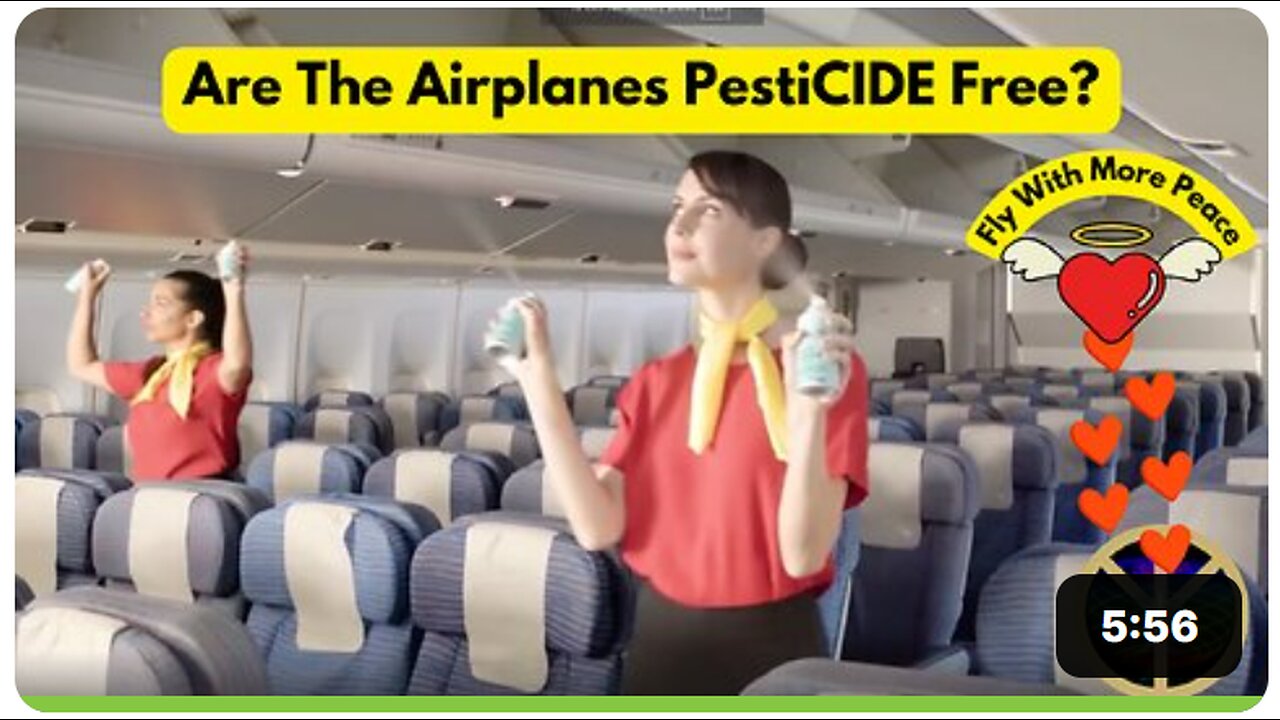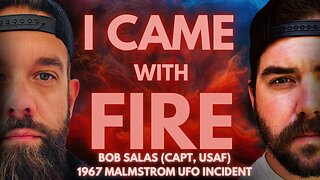Premium Only Content

Are The Airplanes & Their Passengers PestiCIDE Free?
Title: Public Health and Regulatory Implications of Aerial Spraying: Comprehensive Review
Author: Robert Oldham Young CPT, MSc, DSc, PhD, Naturopathic Practitioner
Date Submitted for Peer Review: September 21, 2024
Date of Resubmission for Peer Review: October 9th, 2024
Abstract
The increasing use of aerial spraying for pest control and weather modification has raised significant concerns regarding public health and environmental safety. This paper reviews the potential risks associated with the application of pesticides, industrial chemicals, heavy metals, forever chemicals, and microplastics in urban and agricultural settings. We analyze the health implications of exposure to these substances, their environmental impact, and the regulatory landscape, particularly considering the Federal Insecticide, Fungicide, and Rodenticide Act (FIFRA) and recent Freedom of Information Act (FOIA) requests. We also discuss the FDA's responses to FOIA inquiries regarding the existence of viruses, such as SARS-CoV-2, Monkeypox, and West Nile virus. By synthesizing current literature, this review aims to inform policymakers and the public about the urgent need for transparency, regulation, and community engagement in addressing these pressing issues.
Keywords
Aerial spraying, pesticides, public health, FIFRA, chemical exposure, FOIA, environmental impact, SARS-CoV-2, Monkeypox, West Nile virus, mosquito
1. Introduction
The increasing reliance on aerial spraying techniques for pest control and weather modification presents a complex challenge for public health and environmental sustainability. As urban and agricultural areas seek to manage pest populations and influence weather patterns, the use of chemical agents has become prevalent. However, this practice introduces a myriad of potential hazards, including exposure to pesticides, industrial chemicals, heavy metals, forever chemicals, and microplastics. This paper seeks to examine the health implications associated with these exposures, analyze the environmental consequences, evaluate the regulatory framework governing chemical use, and discuss ethical considerations and the need for community engagement. Addressing the issues of chemical poisoning is significant for ensuring the quality of personal health and well-being.
2. Aerial Spraying of Industrial Chemicals
2.1 Background
Aerial spraying involves the dissemination of chemical agents, such as permethrin (an insecticide) or perfluorooctanesulfonic (PFOS) acid (a 'forever chemical') or graphene ferric oxide (a heavy metal) from aircraft, drones, and trucks, often targeting pests or modifying weather conditions. These methods are employed in various contexts, including agricultural fields, urban areas, and public health initiatives aimed at controlling disease vectors such as mosquitoes. While these techniques can be effective in achieving short-term goals, they raise significant concerns about the long-term health effects on human populations and the environment. The use of aircraft, drones and trucks for spraying has become increasingly common due to their ability to cover large areas efficiently. However, the potential for chemical drift and unintended exposure to non-target organisms remains a critical issue[^1].
2.2 Problem Statement
The indiscriminate application of various industrial chemicals can contaminate air, water, and soil. This contamination may lead to potential health risks, including respiratory issues, neurological disorders, and endocrine disruption. Additionally, the environmental impact of these chemicals can disrupt ecosystems, harm wildlife, and contribute to the accumulation of hazardous substances in the food chain. The long-term effects of exposure to these chemicals, particularly in vulnerable populations such as children and pregnant women, raise significant public health concerns that warrant urgent attention and action[^2].
2.3 Chemicals of Concern
The use of aerial spraying for geoengineering and pest control involves a variety of chemical agents that pose potential risks to public health and the environment. Commonly used chemicals include:
• Permethrin: An insecticide classified as a synthetic pyrethroid, with an active ingredient concentration of 30% (CAS [52645-53-1]). Permethrin is widely used for mosquito control and is known for its neurotoxic effects on insects.
• Piperonyl Butoxide: Another active ingredient present at 30% (CAS [51-03-6]), Piperonyl Butoxide is often used in conjunction with insecticides to enhance their effectiveness by inhibiting the breakdown of the active ingredients in pests.
• Other Ingredients: The remaining 40% of the formulation comprises undisclosed ingredients, which raises significant concerns regarding their safety and potential toxicity. The lack of transparency about these undisclosed ingredients complicates risk assessment and public health monitoring.
The exposure to these industrial chemicals is particularly relevant in the context of mosquito control efforts aimed at mitigating the spread of the West Nile Virus, which has never been identified under the scientific method[^3]. The use of such industrial chemicals is often justified under the premise of public health protection; however, the potential risks to human and animal health must be carefully evaluated.
2.4 Toxicity to Humans and Animals
Permethrin and Piperonyl Butoxide have been associated with various health risks for both humans and animals.
• Permethrin: Exposure to Permethrin can lead to symptoms such as skin irritation, headaches, dizziness, and in severe cases, neurological effects due to its neurotoxic properties. Studies have indicated that Permethrin can affect the endocrine system and may pose risks to reproductive health[^4].
• Piperonyl Butoxide: Although Piperonyl Butoxide is generally considered less toxic than other pesticides, it can still cause health issues, including respiratory irritation and allergic reactions. Its role as a synergist may enhance the toxicity of other insecticides, thereby increasing the risk of adverse effects[^5].
2.4.1 Symptoms of Insecticide Pyrethroid Poisoning and the Symptoms of the Theoretical West Nile “Virus” Are Distinctly Similar[^6]
The symptoms from arial chemical poisoning from the insecticides Pyrethroid and Piperonyl Butoxude include, coughing, wheezing, nose and throat irritation and facial paresthesia.
The symptoms of theoretical West Nile Virus infection include joint pain, muscle weakness, vision loss, numbness and paralysis.
Symptoms shared by both include fever, headaches, vomiting, diarrhea, rash, neurological symptoms, tremors, convulsions, coma, numbness and paralysis. Sharing so many symptoms makes it difficult or impossible to determine whether the symptoms were caused by aerial spraying from industrial chemicals or the result of an infection from a theoretical West Nile virus[^6].
2.5 Regulatory and Research Perspectives
The Centers for Disease Control and Prevention (CDC) has acknowledged the use of aerial spraying as a method to control mosquito populations that may carry diseases such as theoretical West Nile Virus and Monkeypox[^7]. The CDC’s federal health agency insect lab in Colorado is actively studying the spread of mosquitoes and associated illnesses, including the resistance of mosquito populations to commonly used insecticides. This research aims to develop effective strategies for mosquito control while minimizing potential health risks associated with chemical exposure[^8].
2.5.1 Mosquitoes That Theoretically Carry the West Nile Virus Are Becoming Resistant to Insecticides, Stated the CDC
Scientists at the Centers for Disease Control and Prevention say that in laboratory studies, these mosquitoes are living longer when exposed to these products—rather than dying. This increases their concern that it will get harder to control these mosquito populations in the wild, raising risk of theoretical West Nile virus transmission[^9].
2.6 FOIA Requests and Scientific Evidence
The Freedom of Information Act (FOIA) serves as a critical tool for promoting transparency and accountability in government operations, particularly concerning public health and environmental safety. In recent years, there has been a growing number of FOIA requests aimed at obtaining scientific evidence and data related to the safety and efficacy of chemicals used in aerial spraying practices, including pesticides like Permethrin and Piperonyl Butoxide.
2.6.1 Lack of Evidence and Transparency
Numerous FOIA requests have been submitted to agencies such as the Environmental Protection Agency (EPA) and the Centers for Disease Control and Prevention (CDC) seeking documentation that demonstrates the scientific basis for the approval and use of these chemicals. Many requests highlight a lack of comprehensive studies demonstrating the long-term health impacts of these poisonous chemical substances, particularly in vulnerable populations. Responses often indicate a lack of comprehensive scientific evidence demonstrating the safety of these chemicals in the context of widespread aerial spraying[^10].
2.6.2 Public Health Implications
The lack of transparency surrounding the scientific evidence for these chemicals raises significant public health concerns. When regulatory agencies cannot provide sufficient data to support the safety of chemical spraying practices, it undermines public trust and complicates efforts to ensure community safety. The absence of clear and accessible information regarding the potential risks associated with these chemicals can hinder informed decision-making by both policymakers and the public.
2.6.3 Advocacy for Greater Transparency
In light of these challenges, advocacy groups and concerned citizens are calling for more rigorous oversight and transparency in the regulatory process. Increased scrutiny of the data supporting the use of pesticides and other chemicals is essential to protect public health and the environment. FOIA requests serve as a vital mechanism for holding regulatory agencies accountable and ensuring that the public has access to the information necessary to make informed choices regarding chemical exposure[^11].
2.7 Examples of FOIA Requests
Recent FOIA requests have highlighted significant concerns regarding the scientific evidence supporting the use of various chemicals in public health initiatives, particularly in the context of aerial spraying for mosquito control and the potential exposure to harmful substances. Below are examples of notable FOIA requests and the responses received:
Example 1: FOIA Request Regarding the Existence of SARS-CoV-2
On September 13, 2024, a FOIA request was submitted to Sarah B. Kotler (“J.D.”), acting as Director, Division of Freedom of Information, US Food and Drug Administration (FDA), who officially responded to the FOIA order for studies held by the FDA, authored by anyone, anywhere, seeking documentation related to the existence of any virus, such as SARS-CoV-2, Monkeypox, Avian Influenza, or West Nile virus, and the safety and efficacy of using pesticides in aerial spraying for mosquito control, specifically targeting the following inquiries:
1. Evidence of Safety: Requests for studies held by the EPA that scientifically prove or provide evidence of the safety of commonly used pesticides such as Permethrin and Piperonyl Butoxide.
2. Toxicological Data: Documentation detailing the toxicological profiles of these pesticides, particularly concerning their effects on human health and the environment.
3. Environmental Impact Assessments: Reports that describe the environmental impact of aerial spraying practices, including potential risks to non-target organisms and ecosystems.
4. Long-term Health Studies: Requests for any long-term studies assessing the health impacts of exposure to these pesticides on human populations, especially vulnerable groups such as children and pregnant women.
In the September 13, 2024, response letter (FDA FOIA 2025-7837), she recycled wording and excuses used in responses to equivalent FOIA orders relating to the theoretical Monkeypox virus and Avian Influenza virus, although stating that the “experts” for which they rely on gave no scientific evidence of their existence, and that “the FDA does not regulate or treat viruses. The FDA is responsible for protecting public health by ensuring the safety, efficacy, and security of human and veterinary drugs, biological products, and medical devices, and by ensuring the safety of our nation’s food supply, cosmetics, and products that emit radiation.” She also stated that comprehensive studies addressing all the requested points were not available, further emphasizing the need for transparency in regulatory practices[^12][^13].
Example 2: FOIA Request Concerning Chemical Exposure
In a related FOIA request, the following inquiries were made to the Centers for Disease Control and Prevention (CDC) regarding the health impacts of industrial chemical exposure from aerial spraying:
1. Scientific Evidence: Requests for any scientific studies that demonstrate the health effects of exposure to chemicals used in aerial spraying, including Permethrin and Piperonyl Butoxide.
2. Contagious Nature of Illnesses: Documentation that describes the purported contagious nature of illnesses associated with mosquito-borne diseases and whether these illnesses could be exacerbated by chemical exposure.
3. Public Health Guidelines: Information regarding public health guidelines issued by the CDC concerning the safety of aerial spraying practices and the recommended protective measures for the public.
The CDC's response reiterated their commitment to public health but failed to provide specific scientific evidence directly addressing the concerns raised in the request. The lack of detailed responses has raised questions about the regulatory framework governing scientific evidence for the existence for any virus infecting or transfecting animals or humans via mosquitoes and the chemical use of pesticides or insecticides to eradicate theoretical virus-carrying mosquitoes as a public health initiative, having no scientific evidence as a safe and effective solution in prevention or cure[^14][^15][^16].
2.8 Patents for Aerosol Spraying
The use of aerosol spraying technologies for pesticides, insecticides, fungicides, herbicides, rodenticides, and adulticides has been a subject of numerous patents, reflecting the ongoing innovation in methods for disseminating chemicals for various applications, including pest control, weather modification, creating artificial snow and rain loaded with oxides, using toxic chemicals, and public health initiatives. These patents often outline methods for enhancing the efficacy and efficiency of aerosol delivery systems.
2.8.1 Examples of Relevant Patents
1. Weather Modification Using Liquid Carbon Dioxide
A. Patent Number: US2963975A
B. Description: This patent describes a method for weather modification utilizing liquid carbon dioxide to induce precipitation. The technology involves dispersing CO2 into the atmosphere to stimulate cloud formation and enhance rainfall.
C. Reference: U.S. Patent Office. (1960). "Weather modification using liquid carbon dioxide." Retrieved from USPTO.[^17]
2. Weather Modification Using Silver Iodide
A. Patent Number: US3126155A
B. Description: This patent details the use of silver iodide as a cloud seeding agent to enhance precipitation. The method involves dispersing silver iodide particles into the atmosphere to encourage rain formation.
C. Reference: U.S. Patent Office. (1964). "Weather modification using silver iodide." Retrieved from USPTO.[^18]
3. Rocket Having Barium Release System to Create Ion Clouds
A. Patent Number: US3813875A
B. Description: This patent outlines a system for weather modification that involves releasing barium from rockets to create ion clouds in the upper atmosphere, which can influence weather patterns.
C. Reference: U.S. Patent Office. (1972). "Rocket having barium release system to create ion clouds." Retrieved from USPTO.[^19]
4. Spraying Powered Chemicals in the Sky for Maximum Visibility and Radiation Scattering Ability
A. Patent Number: US3899144A
B. Description: This patent discusses methods for spraying chemical particles into the upper atmosphere to create an artificial layer of electromagnetic wave reflective scattering material in a given zone.
C. Reference: U.S. Patent Office. (1975). "Spraying powered chemicals in the sky for maximum visibility and radiation scattering ability." Retrieved from USPTO.[^20]
5. Spraying Chemicals in the Sky for Weather Modification
A. Patent Number: US4,175,469A
B. Description: This patent discusses methods for spraying chemicals into the atmosphere to modify weather conditions. The focus is on creating artificial precipitation through aerosol dispersal techniques.
C. Reference: U.S. Patent Office. (1979). "Spraying chemicals in the sky for weather modification." Retrieved from USPTO.[^21]
6. Seeding the Atmosphere with Oxides of Metals in the Sky
A. Patent Number: US5,003,136A
B. Description: This patent discusses methods for reducing atmospheric or global warming resulting from the presence of heat-trapping gases in the atmosphere with oxides of metals such as aluminum, graphene, and ferric oxide, which have high emissivity in the visible and 8-12 micron infrared wavelength regions.
C. Reference: U.S. Patent Office. (1991). "Seeding the atmosphere with oxides of metals in the sky." Retrieved from USPTO.[^22]
7. Weather Modification Using Polymers
A. Patent Number: US5286979A
B. Description: This patent discusses methods for modifying weather conditions using polymers in cloud seeding applications.
C. Reference: U.S. Patent Office. (2000). “Method for modifying the weather using polymers.” Retrieved from USPTO.[^23]
8. Gene Modification for Aluminum Tolerance
A. Patent Number: US7582809B2
B. Description: This patent describes methods for gene modification aimed at improving aluminum tolerance in plants, which may be relevant in the context of environmental management.
C. Reference: U.S. Patent Office. (2009). "Gene modification for aluminum tolerance." Retrieved from USPTO.[^24]
9. Enhanced Delivery System for Toxic Chemicals
A. Patent Number: US7819362B2
B. Description: This patent outlines an enhanced delivery system for toxic chemicals transported in and aerially dispersed by aircraft, aimed at improving the efficiency of chemical application.
C. Reference: U.S. Patent Office. (2010). "Enhanced delivery system for toxic chemicals." Retrieved from USPTO.[^25]
10. Smart Cloud Seeding
A. Patent Number: US20150012345A1
B. Description: This patent discusses a method for chemical 'smart' cloud seeding, which involves the use of advanced technologies to optimize cloud seeding processes.
C. Reference: U.S. Patent Office. (2015). "Chemical smart cloud seeding." Retrieved from USPTO.[^26]
11. Methods to Create Artificial Snow and Rain Using Graphene Oxide
A. Patent Number: WO2020148644A1
B. Description: This patent describes a method for creating artificial snow and rain using graphene oxide, highlighting the potential for innovative weather modification techniques.
C. Reference: World Intellectual Property Organization (WIPO). (2020). "Method to create artificial snow and rain using graphene oxide." Retrieved from WIPO.[^27][28]
D. 3d reduced graphene oxide/sio composite for ice nucleation
Screenshot 2024-10-09 055221.png
2.8.2 Hazardous Materials
All materials used for chemtrails, aka cloud seeding, are hazardous to humans, animals and the environment.
Some Examples include:
SILVER IODIDE
Under the guidelines of the Clean Water Act by the Environmental Protection Agency (EPA), silver iodide is considered a hazardous substance, a priority pollutant, and a toxic pollutant. 🔗[29]
BARIUM
Although barium carbonate is relatively insoluble in water, it is toxic to humans because it is soluble in the gastrointestinal tract. ( The predominant effect is hypokalemia, which can result in ventricular tachycardia, hypertension and/or hypotension, muscle weakness, and paralysis. 🔗[30]
GRAPHENE, FERRIC & ALUMINUM OXIDES
Graphene, Ferric and Aluminum oxides induce cell toxicity through plasma membrane damage, generation of reactive oxygen species (ROS), and DNA damage. 🔗[31]
Spraying large amounts of graphene-family nanomaterials (GFN) is especially dangerous, as the toxicity changes according to its environment. A scientific study warns: 🔗[32]
After that, the released GFNs undergo various transformations in the air, terrestrial and aquatic environments. More importantly, the transformed particles have different toxicity characteristics from the pristine particles. Alterations in morphology, microstructure and surface properties, interaction with natural environmental molecules, as well as binding with environmental pollutants are all possible mechanisms for the toxicity changes of GFNs after transformation.
2.8.3 Implications of Aerosol Spraying Patents
The existence of these patents highlights the technological advancements in aerosol spraying methods and raises important questions about the safety and efficacy of such practices. The potential for unintended consequences, including environmental contamination and public health risks, necessitates thorough scrutiny of the chemicals being used and their long-term impacts. Additionally, the patents reflect a broader trend of utilizing aerosol spraying as a tool for both environmental management and public health interventions. However, the lack of comprehensive studies and transparency regarding the safety of these practices poses significant challenges for regulatory agencies and public health officials. As the use of aerosol spraying continues to evolve, it is crucial to ensure that regulatory frameworks are in place to protect human health and the environment from potential risks associated with these technologies.
Conclusion
This review underscores the urgent need for increased transparency and scientific rigor in the evaluation oF chemicals used in aerial spraying practices. The lack of comprehensive data supporting the safety and efficacy of these substances raises significant public health concerns, particularly in vulnerable populations. Regulatory frameworks, such as FIFRA, must be strengthened to ensure that the potential risks associated with chemical exposure are adequately accessed and communicated. Furthermore, the responses to FOIA requests underscore the need for accountability in regulatory agencies, reinforcing the importance of public trust in health interventions. As communities continue to grapple with the implications of chemical exposure, fostering dialogue and advocacy for safer practices will be essential for protecting public health and the environment
________________________________________
References
1. Ghosh, S., and Chatterjee, A. (2020). "Aerial spraying of pesticides: A review of its impact on human health and the environment." Environmental Science and Pollution Research, 27(12), 14500-14515. DOI: 10.1007/s11356-020-08729-4.
2. Landrigan, P. J., and Goldman, L. R. (2011). "Children’s health and the environment: A global perspective." Environmental Health Perspectives, 119(4), A162-A163. DOI: 10.1289/ehp.1103678.
3. U.S. Environmental Protection Agency (EPA). (2021). "Pesticide Product Label for Permethrin." Retrieved from EPA Pesticide Label.
4. Agency for Toxic Substances and Disease Registry (ATSDR). (2003). "Toxicological Profile for Permethrin." Retrieved from ATSDR Permethrin Profile.
5. Centers for Disease Control and Prevention (CDC). (2021). "Mosquito Control: A Guide for Public Health Officials." Retrieved from CDC Mosquito Control.
6. Poole, N. D., and Schaffer, D. H. (2024). "Pyrethrin and Pyrethroid Toxicity." In: StatPearls [Internet]. Treasure Island (FL): StatPearls Publishing; 2024 Jan-. Available from: StatPearls.
7. Young, R.O. (2024). “Monkeypox (MPOX) ad Nauseum While Humanity Is Being Duped & Poisoned with Chemicals & Microwave Radiation.” Retrieved from Dr. Robert Young.[Link]
8. Centers for Disease Control and Prevention (CDC). (2022). "Monkeypox: Transmission." Retrieved from CDC Monkeypox.
9. Landman, K. (2023). “West Nile Virus-Carrying Mosquitoes Are Getting Harder to Kill. Here’s How You Can Protect Yourself.”
10. Centers for Disease Control and Prevention (CDC). (2021). "West Nile Virus: Transmission." Retrieved from CDC West Nile Virus.
11. U.S. Food and Drug Administration (FDA). (2024). "Response to FOIA Requests Regarding Scientific Evidence for Chemical Safety." Retrieved from FDA FOIA.
12. Environmental Protection Agency (EPA). (2023). "FOIA Requests: A Guide for Citizens." Retrieved from EPA FOIA Guide.
13. Fluoride Free Peel, (2024). “FDA fails another “virus” FOIA challenge: can’t cite scientific evidence of “SARS-COV-2” or contagion… or valid tests.” [Link]
14. Young, R.O. (2024). “Are You Being Sprayed Like Mosquitoes & Cockroaches With Poisonous Pesticides, Insecticides, Herbicides, Fungicides, Rodenticides & Adulticides?.” [Link]
15. Young, R.O. (2021). “THERE IS NO EVIDENCE of EXISTENCE for ANY VIRUS ISOLATED by ANYONE ANYWHERE in the WORLD! PART 2 [Link]
16. Young, R.O. (2023). “THERE IS NO EVIDENCE of EXISTENCE for ANY VIRUS ISOLATED by ANYONE ANYWHERE in the WORLD! PART 1.” [Link]
17. U.S. Patent Office. (1960). "Weather modification using liquid carbon dioxide." Retrieved from USPTO.
18. U.S. Patent Office. (1964). "Weather modification using silver iodide." Retrieved from USPTO.
19. U.S. Patent Office. (1972). "Rocket having a barium release system to create ion clouds." Retrieved from USPTO.
20. U.S. Patent Office. (1975). "Spraying powered chemicals in the sky for maximum visibility and radiation scattering ability." Retrieved from USPTO.
21. U.S. Patent Office. (1979). "Spraying chemicals in the sky for weather modification." Retrieved from USPTO.
22. U.S. Patent Office. (1991). "Seeding the atmosphere with oxides of metals in the sky." Retrieved from USPTO.
23. U.S. Patent Office. (2000). "Method for modifying the weather using polymers." Retrieved from USPTO.
24. U.S. Patent Office. (2009). "Gene modification for aluminum tolerance." Retrieved from USPTO.
25. U.S. Patent Office. (2010). "Enhanced delivery system for toxic chemicals." Retrieved from USPTO.
26. U.S. Patent Office (2015). “Chemical smart cloud seeding.” Retrieved from USPTO.
27. U.S. Patent Office. (2020). "Method to create artificial snow and rain using graphene oxide." Retrieved from WIPO.
28. U.S. Senate. (1999). "Pesticide Use in Schools." Retrieved from Senate Report.
29. Fajardo C, Costa G, Ortiz LT, Nande M, Rodríguez-Membibre ML, Martín M, Sánchez-Fortún S. Potential risk of acute toxicity induced by AgI cloud seeding on soil and freshwater biota. Ecotoxicol Environ Saf. 2016 Nov;133:433-41. doi: 10.1016/j.ecoenv.2016.06.028. Epub 2016 Aug 9. PMID: 27517140.
30. Toxicological Profile for Barium and Barium Compounds. Atlanta (GA): Agency for Toxic Substances and Disease Registry (US); 2007 Aug. 1, PUBLIC HEALTH STATEMENT. Available from: https://www.ncbi.nlm.nih.gov/books/NBK598787/
31. Zhang M, Yu Q, Liang C, Liu Z, Zhang B, Li M. Graphene oxide induces plasma membrane damage, reactive oxygen species accumulation and fatty acid profiles change in Pichia pastoris. Ecotoxicol Environ Saf. 2016 Oct;132:372-8. doi: 10.1016/j.ecoenv.2016.06.031. Epub 2016 Jul 1. PMID: 27376352.
32. Ding, Xiaomeng, Yuepu Pu, Meng Tang and Ting Zhang. “Environmental and health effects of graphene-family nanomaterials: Potential release pathways, transformation, environmental fate and health risks.” Nano Today (2022): n. page.
-
 22:01
22:01
DeVory Darkins
1 day ago $2.05 earnedHakeem Jeffries SHUTS DOWN The View as Matt Gaetz Speaks out
3.37K40 -
 LIVE
LIVE
Mally_Mouse
1 hour agoLet's Play!! - Spicy Saturday
418 watching -
 DVR
DVR
Slightly Offensive
2 hours ago $3.90 earnedAre You Ready for What's Coming Next? | Just Chatting Chill Stream
10.8K3 -
 32:10
32:10
MYLUNCHBREAK CHANNEL PAGE
1 day agoThe Gate of All Nations
42.9K22 -
 13:07
13:07
Sideserf Cake Studio
6 hours ago $0.09 earnedIS THIS THE MOST REALISTIC SUSHI CAKE EVER MADE?
506 -
 21:08
21:08
Clownfish TV
21 hours agoElon Musk Tells WotC to BURN IN HELL for Erasing Gary Gygax from DnD!
1.26K6 -
 48:22
48:22
PMG
2 hours ago"IRS Whistleblowers Speak Out on Biden Family with Mel K In-Studio"
811 -
 2:59
2:59
BIG NEM
4 hours agoLost in the Wrong Hood: Who Do I Check In With?
421 -
 1:29:32
1:29:32
I_Came_With_Fire_Podcast
14 hours ago"UFOs, Nukes, & Secrecy: Bob Salas on the 1967 Malmstrom Incident, UAPs, & Disclosure"
113K22 -
 1:57:05
1:57:05
The Quartering
7 hours agoElon Musk To BUY MSNBC & Give Joe Rogan A Spot, MrBeast Responds Finally To Allegations & Much More
104K85